Illustration of a Plant Cell Easy 7th Grade
Definition of plant cell
Plant cells are eukaryotic cells, that are found in green plants, photosynthetic eukaryotes of the kingdom Plantae which means they have a membrane-bound nucleus. They have a variety of membrane-bound cell organelles that perform various specific functions to maintain the normal functioning of the plant cell.
Structure of Plant cell
Generally, plant cells are a lot bigger than animal cells, coming in more similar sizes and they are typically cubed or rectangular in shape. Plant cells also have structural organelles that are not found in the animals' cells including the cell wall, vacuoles, plastids e. g Chloroplast. Animal cells also contain structures that are not found in the plant cells such as, cilia and flagella, lysosomes, and centrioles.
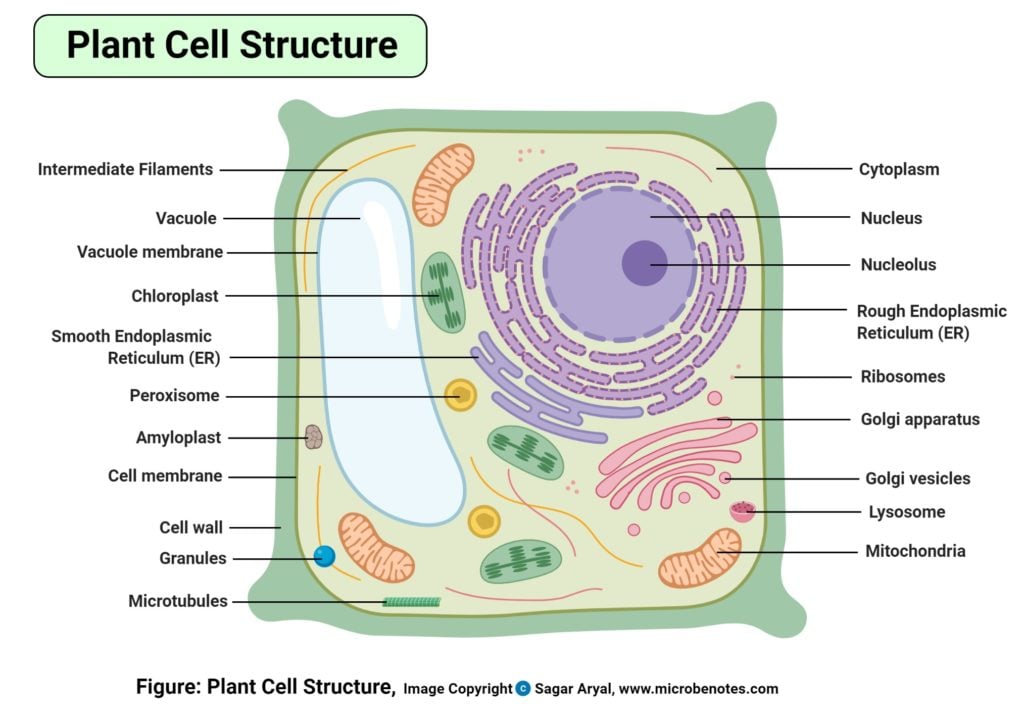
Figure: Labeled diagram of plant cell, created with biorender.com
The typical characteristics that define the plant cell include cellulose, hemicellulose and pectin, plastids which play a major role in photosynthesis and storage of starch, large vacuoles responsible for regulating the cell turgor pressure. They also have a very unique cell division process whereby there is the formation of a phragmoplast (a complex made up of microtubules, microfilaments, and the endoplasmic reticulum) all assembling during cytokinesis, to separate the daughter cells.
These organelles most of them are similar to the animal organelles performing the same functions as those of the animal cell. Organelles have a wide range of responsibilities that include everything from producing hormones and enzymes to providing energy for a plant cell.
Plants cells have DNA that helps in making new cells, hence enhancing the growth of the plant. the DNA is enclosed within the nucleus, an enveloped membrane structure at the center of the cell. The plant cell also has several cell organelle structures performing a variety of functions to maintain cellular metabolisms, growth, and development.
Plant Cell Free Worksheet
Answer key
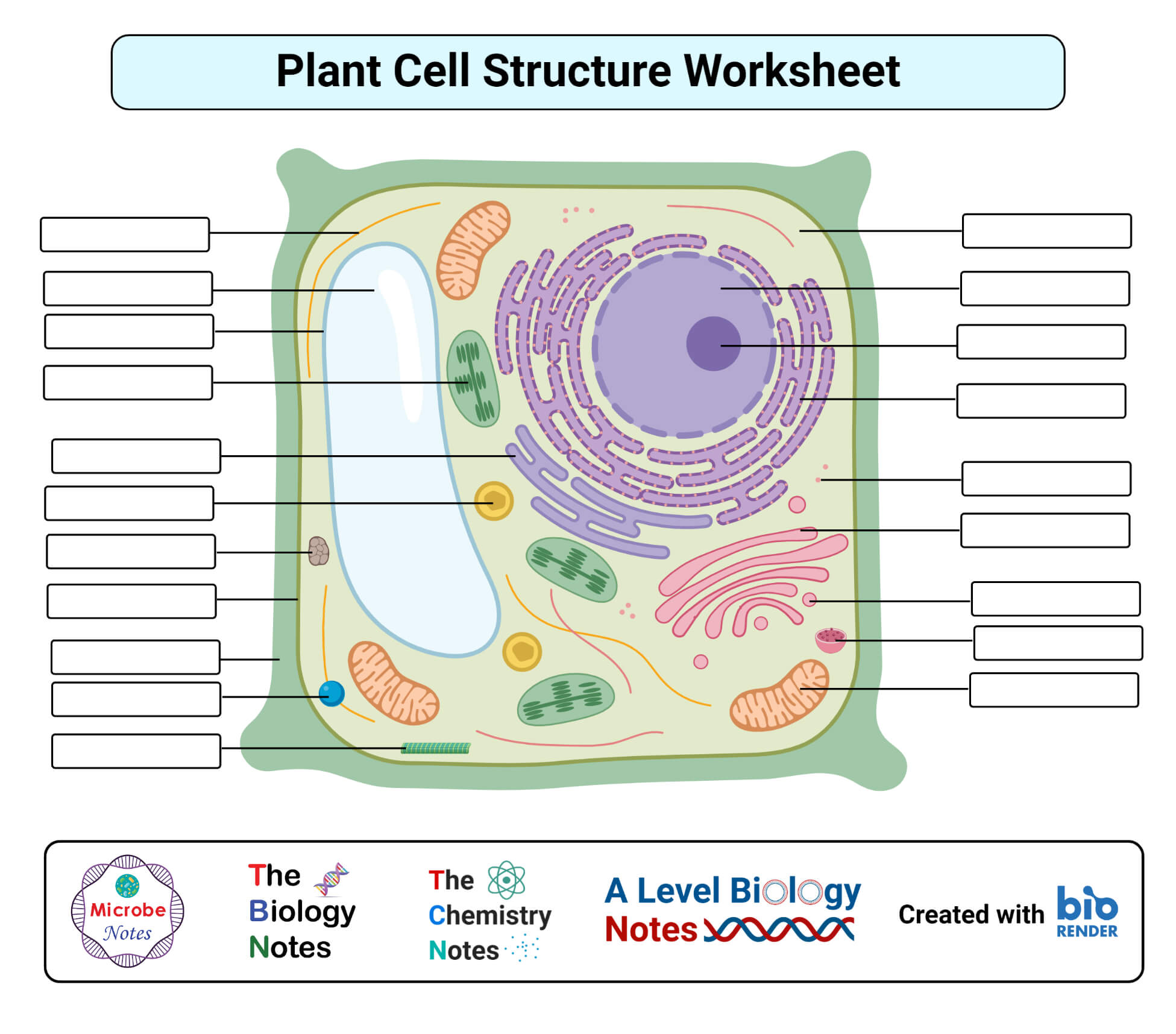
List of Plant cell organelles
- Cell Wall
- Cytoskeleton
- Cell (Plasma) membrane
- Plasmodesmata
- The cytoplasm
- Plastids
- Plant Vacuoles
- Mitochondria
- Endoplasmic reticulum (ER)
- Ribosomes
- Storage granules
- Golgi bodies
- Nucleus
- Peroxisomes
Plant Cell Wall
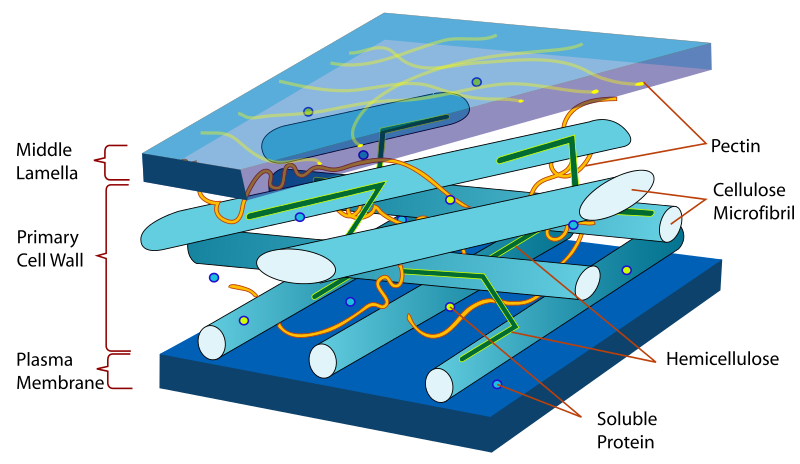
Figure: Diagram of Plant cell wall. Source: Wikipedia
Definition of plant cell wall
It is the rigid outer cover of the plant cell with a major role of protecting the plant cell, giving it, its shape.
Structure of plant cell wall
- It is a specialized matrix that covers the surface of the plant cell. Every plant cell has a cell wall layer which is a major distinguishing factor between a plant cell and an animal cell.
- The cell wall is made up of two layers, a middle lamella, and a primary cell wall and sometimes a secondary cell wall.
- The middle lamella acts as the strengthening layer between the primary walls of the neighboring cells.
- The primary wall is made up of cellulose underlying the cells that are dividing and maturing. The primary wall is a lot thinner and less rigid as compared to those of the cells that have reached complete maturation. The thinness allows the cell wall to expand.
- After full cell growth, some plants get rid of the primary wall but most, they thicken the primary wall or it makes another layer with rigidity but a different arrangement, known as the secondary wall.
- The secondary wall offers permanent stiff mechanical support to the plant cell especially the support found in wood.
- In contrast to the permanent stiffness and load-bearing capacity of thick secondary walls.
The function of the plant cell wall
The primary role of the cell wall is defined to be a mechanical and structural function, that is highly effective in serving the plant cell. These functions include:
- Providing the cell with mechanical protection and shielding the cell from the chemically harsh environment, provided by the secondary wall layer.
- It is semipermeable hence it allows in and out, the circulation of materials such as water, molecular nutrients, and minerals.
- It also forms provides a rigid building block to stabilize the plant to produce some of its structures, for example, the stem and leaves of the plants.
- It also provided a site for the storage of some elements such as the regulatory molecules that detect pathogens in the plant, hindering the development of diseased tissue.
- The thin primary walls serve as structural and supportive functional layers when the cell vacuoles are filled with water, exerting turgor pressure on the cell wall, thus maintaining the plants' stiffness and preventing plants from losing water and withering.
The basic building block is made of cellulose fibers, of both the primary and secondary walls, despite having different compositions and structures. Cellulose is a polysaccharide matrix that offers tensile strength to the cells. This strength is entrenched within the highly concentrated matrix of water and glycoproteins.
Plant cytoskeleton
Figure created with biorender.com
Definition of the plant cytoskeleton
This is a network of microtubules and filaments that plays a primary role in maintaining the plant cell shape and giving the cell cytoplasm support and maintaining its structural organization. These filaments and tubules normally extend all over the cell, through the cell cytoplasm. Besides giving support and maintaining the cell and the cell cytoplasm, its also involved in the transportation of cellular molecules, cell division, and cell signaling activities.
Structure of the plant cytoskeleton
The cytoskeleton has an essential definition of the structure of eukaryotic cells, describing the support system of these cells, the maintenance factors and transport involvements within the cell. These functions are defined by the structure of the cytoskeleton which is made up of three filaments i. e actin filament (microfilaments), microtubules and intermediate filaments.
- Microfilaments, also known as actin filaments, are a meshwork of fibers running parallel to each other. They are made up of the thin strands of actin proteins hence the name actin filaments. They are the thinnest filaments of the cytoskeleton with a thickness of 7 nanometers.
- Intermediate filaments have a diameter of about 8-12 nm; They lie between the actin filaments and the microtubules. Its function in plant cells is not clearly understood
- Microtubules are hollow tubes made up of tubulins, with a diameter of 23nm. They are the largest filament compared to the other two filaments.
Functions of the plant cytoskeleton
Microfilaments
- They play a primary role is a division of the cell cytoplasm by a mechanism known as cytokinesis, forming two daughter cells.
- They also participate in cytoplasmic streaming, a process of cytosol flow all over the cell, transporting nutrients and cell organelles.
Intermediate Filaments
- The intermediate filaments' role in the plant cells is not clearly understood but has a role to play in maintaining the cell shape, structural support and retain tension within the cell.
Microtubules
- Unlike the role of the microtubule in cell division in the animal cell, the plant cell uses the microtubules to transport materials within the vell and they are also used in forming the plant cell, cell wall.
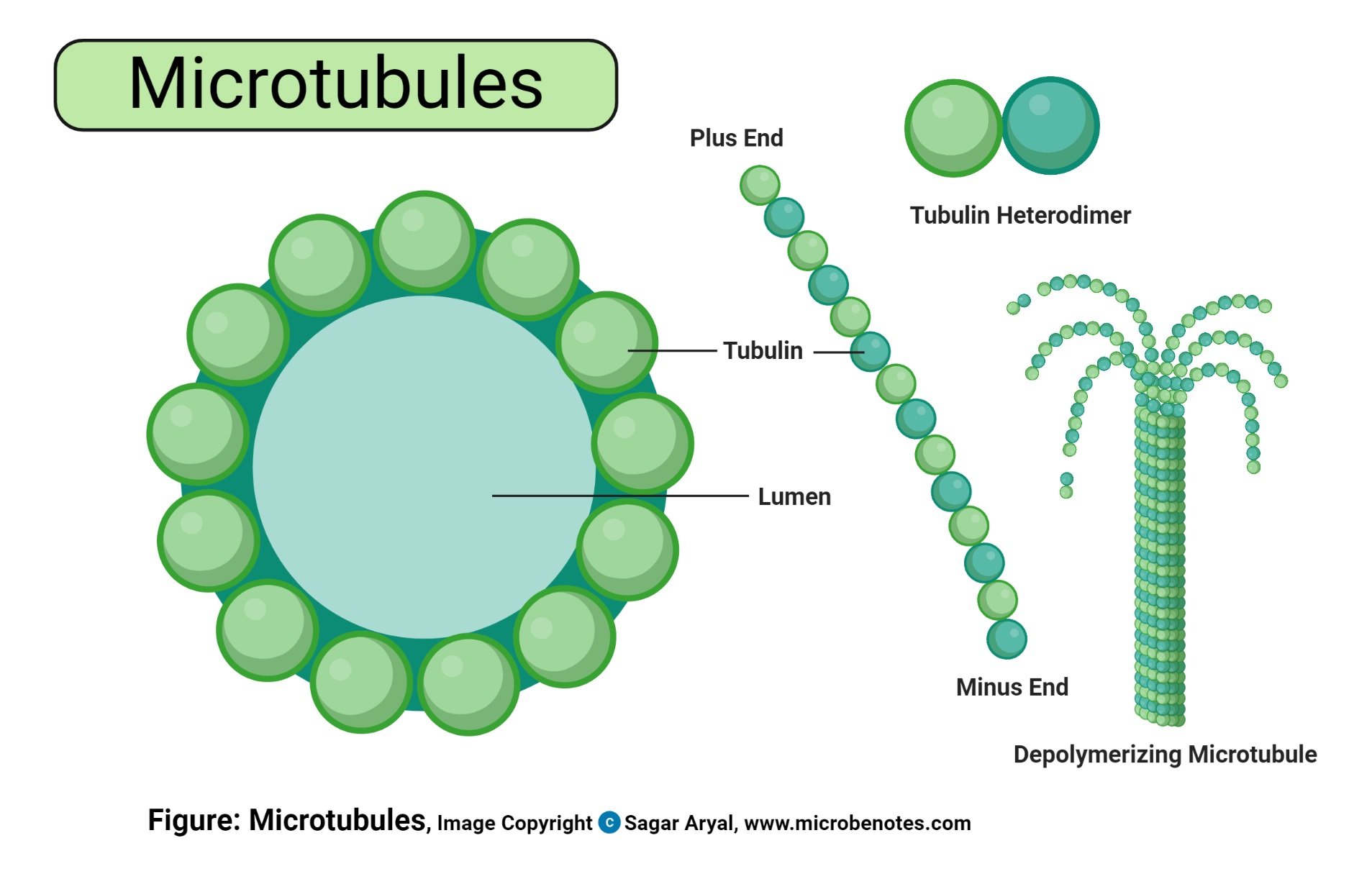
Figure created with biorender.com
Other functions of the cytoskeleton in plants include:
- Giving the plant cell shape, maintaining the cell shape and transportation of some cell organelles throughout the cell, molecules, and nutrients across the cell cytoplasm.
- It also plays a role in mitotic cell division.
- In summary, the cytoskeleton is the frame of building the cell, hence it maintains the cell structure, provides cell structural support and defines the cell structure.
Chloroplast of plant cell
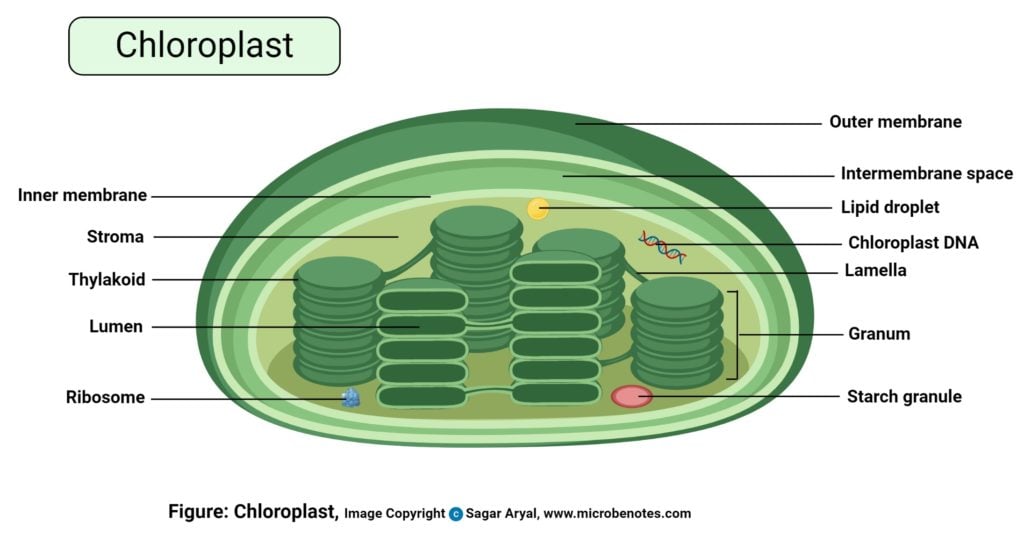
Figure: Diagram of chloroplast, created with biorender.com
Structure of the plant cell chloroplast
- These are organelles found in plant cells and algal cells.
- They are oval-shaped.
- They are made up of two surface membranes, i.e outer and inner membrane and an inner layer known as the thylakoid layer has two membranes.
- The outer membrane forms the external lining of the chloroplast while the inner membrane is below the outer layer.
- The membranes are separated by thin membranous space and within the membrane, there is also a space known as the stroma. The stroma houses the chloroplast.
- The third layer known as the thylakoid layer is extensively folded making the appearance of a flattened disk known as thylakoids which have large numbers of chlorophyll and carotenoids and the electron transport chain, defined as the light-harvesting complex, used during photosynthesis.
- Thylakoids are piled on top of each other in stacks known as grana.
Functions of the plant cell chloroplast
- The chloroplast is the site of food synthesis for plant cells, by a mechanism known as photosynthesis.
- Chloroplasts contain chlorophyll, a green pigment that absorbs light energy from the sun for photosynthesis.
- The photosynthesis process converts water, carbon dioxide, and light energy into nutrients for utilization by the plants.
- Thylakoids contain chlorophyll pigments and carotenoids for trapping light energy for use in photosynthesis.
- the chlorophyll pigment gives plants their green color.
Chromoplast plastid of the plant cell
Chromoplast definition
- Chromoplasts define all the plant pigments stored and synthesized in plants. They are found in a variety of plants of all kinds of ages.
- They are normally formed from the chloroplasts is the name given to an area for all the pigments to be kept and synthesized in the plant.
- The have carotenoid pigments that allow the differentiation in color seen in flowers and fruits. Its color attracts pollination mechanisms by pollinators.
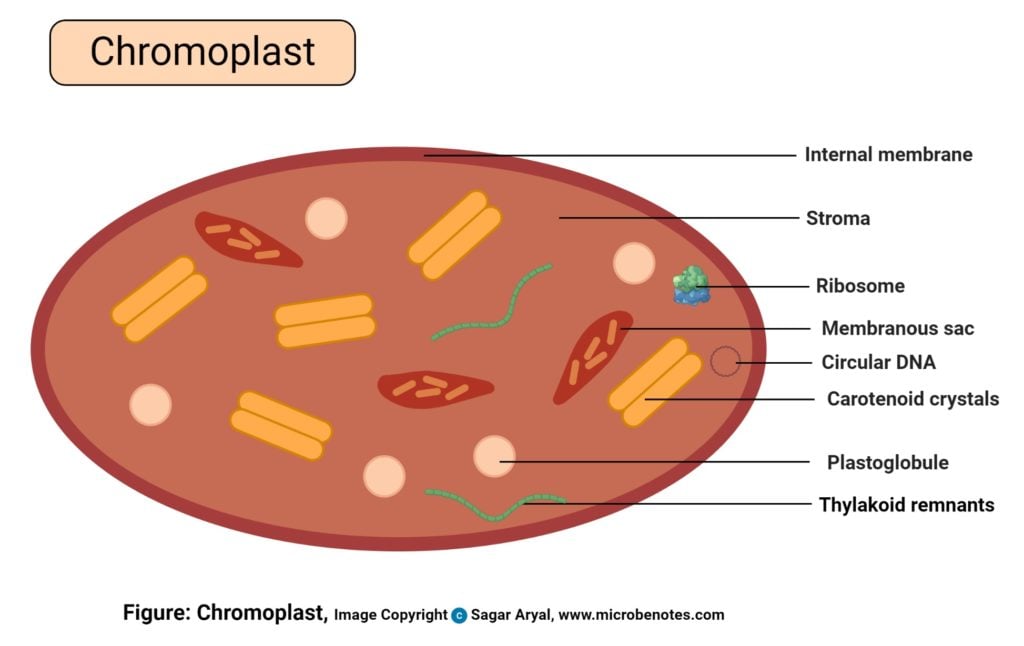
Figure: Diagram of chromoplast, created with biorender.com
Structure of plant chromoplast
Microscopic observation indicates that chromoplast has at least four types:
- Proteic stroma which contains granules
- Amorphous pigment with granules
- Protein and pigment crystals
- Crystalised chromoplast
Although, the more specialized feature has been observed classifying it further into 5 types:
- Globular chromoplasts which appear as globules
- Crystalline chromoplast which appears crystalized
- Fibrillar chromoplast which appears like fibers
- Tubular chromoplast which looks like tubes
- Membranous chromoplast
These chromoplasts live amongst each other though some plants have specific types such as mangoes have the globular chromoplast while carrots have crystallized chromoplast, tomatoes have both crystalline and membranous chromoplast because they accumulate carotenoids.
Functions of plant chromoplast
- They give distinctive colors to plant parts such as flowers, fruits, roots, and leaves. Differentiation of chloroplast to chromoplast makes the fruits of plant ripen.
- They synthesize and store plant pigments such as yellow pigments for xanthophylls, orange for carotenes. This gives the plant and its parts the color.
- They attract pollinators by the colors they produce, which helps in the reproduction of the plant seed.
- Chromoplats found in roots enable the accumulation of water-insoluble elements especially in tubers such as carrots and potatoes.
- They contribute to color change during plant aging, for flowers, fruits, and leaves.
Gerontoplast plastids of the plant cell
- These plastids found in plant leaves are the organelles responsible for cell aging. They differentiate from chloroplast when the plants start to age, and they can not perform photosynthesis anymore.
- They appear as unstacked chloroplasts without a thylakoid membrane and accumulation of plastoglobuli that is used in producing energy for the cell.
- The primary function of Gerontoplast is to aid the aging of the plant parts giving them a distinct color to indicate a lack of photosynthesis process.
Leucoplast plastids of the plant cell
- These are the non-pigmented plastids. Since they lack the chloroplast pigments, they are found in non-photosynthetic parts of the plants like the roots and seeds.
- They are smaller than the chloroplasts, which varying morphologies others appearing ameboid shaped.
- They are interconnected with a network of stromules in roots, flower petals.
- They can be specialized to store starch, lipids, and proteins in large quantities hence named as amyloplasts, elaioplast, and proteinoplast, depending on what they store respectively.
The main function of the leucoplast includes:
- Storage of starch, lipids, and proteins.
- They are also used to convert amino acids and fatty acids.
Plant Vacuoles
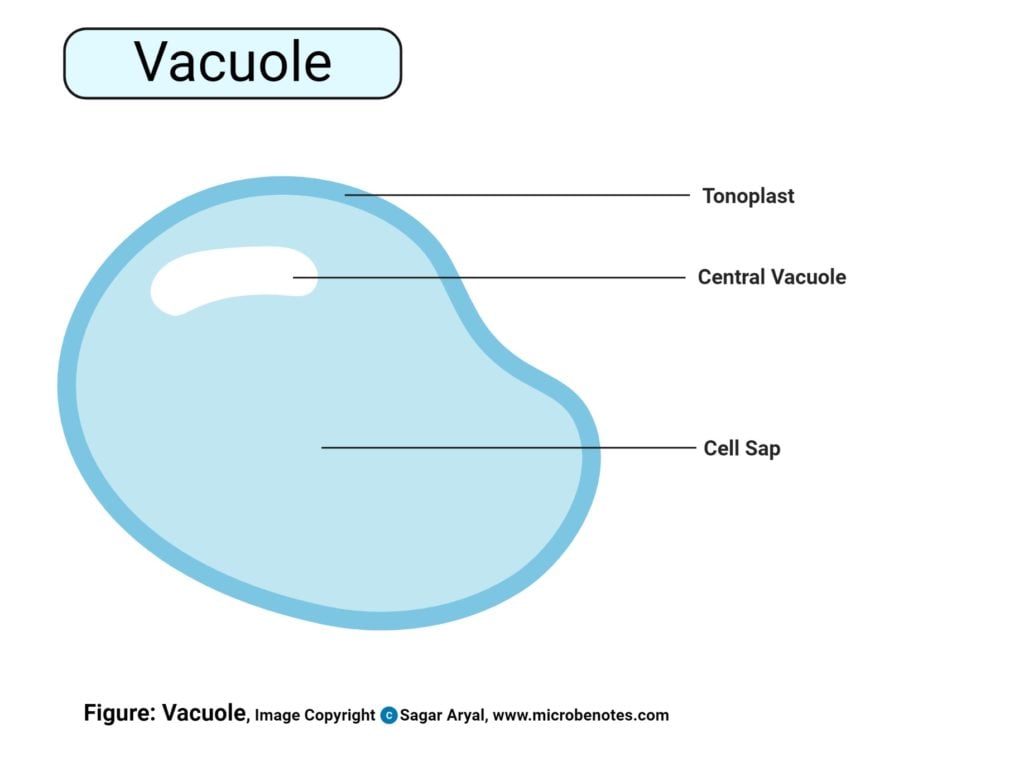
Figure created with biorender.com
Plant vacuoles definition
- Plant cells have large vacuoles as compared to animal cells.
- The central vacuoles are found in the cytoplasmic layer of cells of a variety of different organisms, but larger in the plant cells.
Structure of plant cell vacuoles
- These are large, vesicles filled with fluid, within the cytoplasm of a cell.
- It is made up of 30% fluid of the cell volume but can fill up to 90% of the cell's intracellular space.
Functions of the central vacuole
- The central vacuoles are used to adjusted the size of the cell and to maintains the turgor pressure of the plant cells, preventing wilting and withering of plants especially the leaves.
- When the cytoplasmic volume is constant, the vacuoles account majorly for the size of the plant cell.
- Turgor pressure is maintained when the vacuoles are full of water. When there is no turgor pressure, it is an indication of the plant losing water, hence the plant leaves and stems wither.
- Plant cells thrive in high water levels (Hypotonic solutions), taking up water by osmosis from the environment, thus maintaining turgidity.
- A plant cell can have more than one type of vacuole. some specialized vacuoles especially those structurally related to lysosomes contain degradative enzymes used to break down macromolecules.
- Vacuoles are also responsible for the storage of cellular nutrients including sugars, organic salts, inorganic salts, proteins, cellular pigments, lipids. these elements are stored until when the cell requires them for cellular metabolisms. For example, vacuoles store proteins for seeds and opium metabolites.
Mitochondria of the plant cell

Figure created with biorender.com
Plant cell mitochondria definition
- Mitochondria are also known as chondriosomes, are the power generating organelles of a cell, hence they are commonly known as the powerhouse of the cell.
- The mitochondria convert stored nutrients by the help of oxygen to produce energy in for of (ATP )Adenosine TriPhosphate, hence they are the site for non-photosynthetic energy transduction.
- There are hundreds of mitochondria within a single plant cell.
- Mitochondria are found in high numbers within the phloem pigment of the plant cell, and the neighboring cells have high metabolism rates. This is to supply energies that support various needing mechanisms, like the transportation of food through the sieve tubes.
- As they perform their mechanisms, mitochondria continuously move and change their shapes, depending on its interactions with light trapped for photosynthesis, level of cytosolic sugars and the endoplasmic reticulum mediated interactions.
- The animal and plant mitochondria are very similar except for a few notable differences e.g. mitochondria in plants have reduced nicotinamide adenine dinucleotide (NADH) dehyg=drogenase used for oxidation of exogenous NADH which animal cell lack.
- Mitochondria from many plant sources are relatively insensitive to cyanide inhibition, a feature not found in animal mitochondria. On the other hand, the b -oxidation pathway of fatty acids is located in animal mitochondria, whereas in plants, the enzymes of fatty acid oxidation occur in the glyoxysomes. (https://publishing.cdlib.org/ucpressebooks/view?docId=ft796nb4n2&chunk.id=d0e6787&toc.depth=1&toc.id=d0e6787&brand=ucpress)
Structure of plant mitochondria
- Plant cell mitochondria have high pleomorphism.
- Mitochondria in green plants are discrete, spherical-oval shaped organelles of diameter ranging from 0.2to1.5μm
- The mitochondria have a double-layered system i. e a smooth outer membrane and an inner complex membrane that encloses the organelle matrix.
- The two layers are lipid bilayers complexed with a hydrophobic fatty acid chain. These lipids are a class of phospholipids that are highly dynamic with a strong attraction to the fatty acid regions.
- They have a mitochondrial gel-matrix in the central mass.
- The mitochondria also possess all the enzymes for the Tricarboxylic cycle (TCA) including citrate synthetase, Pyruvate oxidase, Isocitrate Dehydrogenase, Malate Dehydrogenase, Malic Enzyme.
Functions of mitochondria in plants
- The mitochondria are the powerhouse of the cell, hence their major function is generating energy for use by the cell.
- To have a high rate of metabolism because they supply energy for the unknown mechanism by which foods, mainly sucrose, are transported in the sieve tubes.
- Within the mitochondria, the potential energy in food that is manufactured by photosynthesis is what is used for the metabolisms of the cells. For example, energy used for the formation of new cell content, enzyme production and moving of sugar molecules are produced by the mitochondria.
- This is the cite for the Tricarboxylic cycle (TCA), also known as the Krebs cycle. The TCA cycle uses the cell's nutrients, converting them into by-products that the mitochondria use for producing energy. These processes take place in the inner membrane because the membrane bends into folds called the cristae, where the protein components used for the main energy production system cells, known as the Electron Transport Chain (ETC). ETC is the main source of ATP production in the body.
Endoplasmic reticulum (ER) of the plant cell
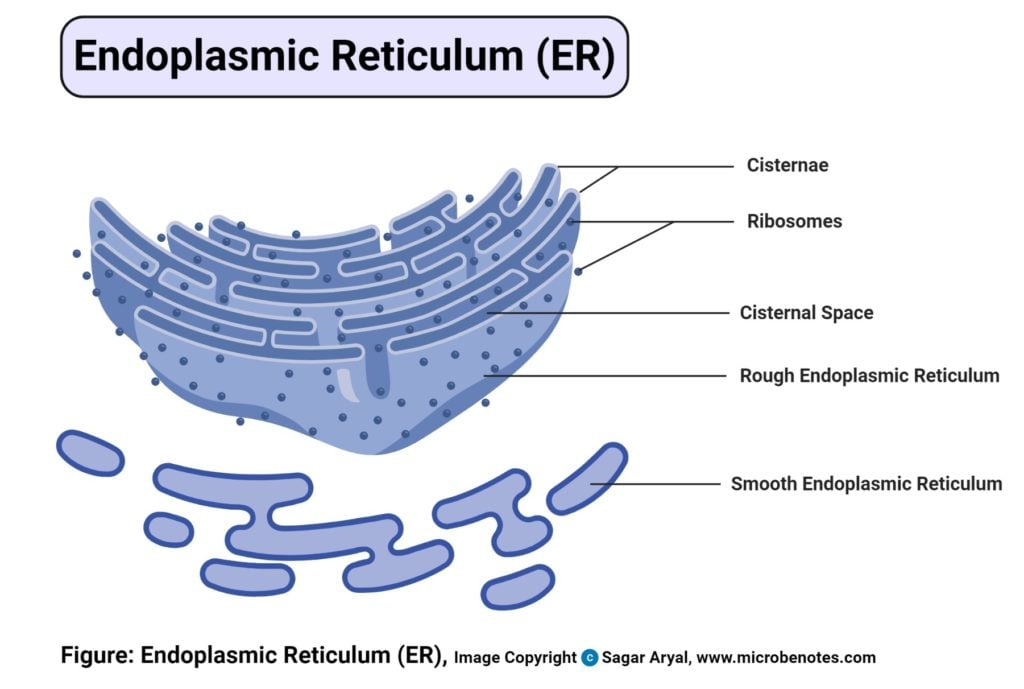
Figure created with biorender.com
Plant cell endoplasmic reticulum (ER) definition
- The ER is a continuous network of folded membranous sacs housed in the cell cytosol. It is a complex organelle taking up a sizable part of the cell's cytosol
- It is made up of two regions known as the rough endoplasmic reticulum (they have ribosomes attached to their surface membrane) and the smooth endoplasmic reticulum (they lack ribosomal attachment).
- The endoplasmic reticulum known for its high dynamics functions in eukaryotic cells, play major roles in synthesizing, processing, transporting and storing proteins, lipids, and chemical elements. These elements are used by the plant cell and other organelles such as the vacuoles and the apoplast (Plasma membrane).
- The inner space of the ER is known as the lumen.
- It is attached to the nuclear envelope, providing a link between the nucleus and the cell cytosol, and also giving a link between the cell to the plasmodesmata tubes, which connect to the plant cells. It accounts for 10% of the volume of the cytosol.
- On the other hand, rough ER almost always appears as stacks of double membranes that are heavily dotted with ribosomes. Based on the consistent appearance of rough ER, it most likely consists of parallel sheets of membrane, rather than the tubular sheets that characterize smooth ER.
- These flattened, interconnected sacs are called cisternae, or cisternal cells. The cisternal cells of rough ER are also referred to as luminal cells. Rough ER and the Golgi complex are both composed of cisternal cells.
Structure of plant cell endoplasmic reticulum
- This is a consistently folded membranous organelle found in the cytoplasm of the cell, that is made up of a thin network of flattened interconnected compartments (sacs) that connects from the cytoplasm to the cell nucleus.
- Within its membranes, there are membranous spaces called thecristae spaces and the membrane folding are calledcristae.
- There are two types of ER based on their structure and the function they perform includingRough Endoplasmic reticulum and theSmooth endoplasmic reticulum.
Functions of the endoplasmic reticulum
Functions of the Rough and smooth endoplasmic reticulum
- The Rough endoplasmic reticulum is covered by ribosomes around its surface membrane, making a rough bumpy appearance. the primary role of the Rough ER in synthesizing proteins, which are transported from the cell to the Golgi bodies, which carry them to other parts of the plant to help in its growth. These proteins are an assembly of amino acid sequences that combine to form antibodies, hormones, digestive enzymes. the assembling is accomplished by the ribosomes attached to the rough ER.
- Some proteins are processed outside the cell, they can also be transported into the Rough ER where they undergo assembling into the right shape and dimensions for cell utilization and conjugated with sugar elements to form a complete protein. these complexes are then transported and distributed to parts of the ER known as the transitional ER, for packaging in cell vesicles and passed to the Golgi bodies which export them to other parts of the plant.
- The smooth ER is smooth due to a lack of attached surface ribosomes. They look as though they are budding off from the lumen of the rough endoplasmic reticulum. Its role is synthesizing, secreting and storing lipids, metabolizing carbohydrates and manufacturing of new membranes. This is enhanced by the presence of several enzymes bound to its surface.
- When a plant has enough energy for utilization for photosynthesis and still possess excess lipids manufactured by the cell, these lipids are stored in the smooth Endoplasmic reticulum in the form of triglycerides. And when the cell needs more energy, the triglycerides are broken down to produce the energy required by the plants.
- Minimally, the smooth endoplasmic reticulum has also been linked to the formation of the cellulose on the cell wall.
Other functions of the endoplasmic reticulum in the plant cell
- Calcium is used in the growth and development of plant cells which enhances plant growth but in some cases, calcium may be produced in excessive quantities that harm the plant cell by causing cell death. Therefore the Endoplasmic reticulum has been linked to regulating the excess calcium by converting it to calcium oxalate crystals. Specialized cells in the endoplasmic reticulum known as crystal idioblast play a major role in this conversion and also in storing these crystals.
- The ER also act as plant sensors. Plants have the ability to make rapid movements in response to certain external stimuli e. g light intensity, temperature, and atmospheric pressure. In such mechanisms, the ER mediates for the plant to respond accordingly. For example, in Venus flytrap plant, react sensitively to touch, this is due to the presence of the cortical endoplasmic reticulum (Cortex cells) that instantly respond to touch.
- In the event of sensitivity, the sensory ER move and collect at the top and the bottom of the cell, making them be squeezed together thus causing a constraint on them. This leads to the release of accumulated calcium, which in turn produces the sense of touch.
- The cortical ER is highly linked with the plasmodesmata (a narrow thread of cytoplasm that passes through the cell walls of adjacent plant cells and allows communication between them). The Plasmodesmata acts as a channel of communication among the cells thus linking to the motor cells triggering the cells and the plant to respond accordingly.
Ribosomes of the Plant Cell
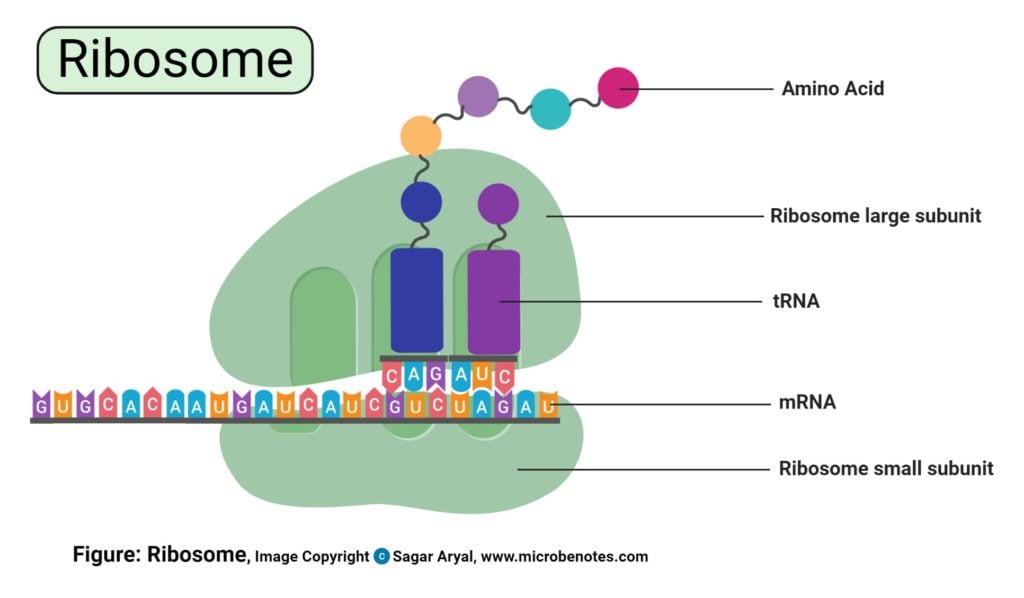
Figure created with biorender.com
Plant cell ribosome definition
- This is the organelle responsible for protein synthesis of the cell.
- Its found in the cell cytoplasm in large numbers and a few of them called functional ribosomes can be found in the nucleus, mitochondria, and the cell chloroplast.
- Its made up of ribosomal DNA (rDNA) and cell proteins
- The process of protein synthesis by the ribosomes is known as translation, by using the messenger RNA, which delivers the nucleotides to the ribosomes.
- The ribosomes then guide and translate the message in the form of nucleotides, contained by the mRNA.
Structure of ribosomes of the plant cell
- The ribosomes' structure is the same in all cells but smaller in prokaryotic cells. Generally, ribosomes in eukaryotic cells are large and they can only be measured in Svedberg units (S). S unit is a measure of aggregation of large molecules to sediments on centrifugation. High S value means fast sedimentation rate hence greater mass.
- Eukaryotic cell sediment in the 90s while prokaryotic cell sediment in the 70s.
- Ribosomes found in the mitochondria and chloroplasts are as small as the prokaryotic ribosomes.
- Naturally, ribosomes are made up of two subunits i. e small and large subunits, both classified according to their sedimentation rates by the S unit.
- The plant cell, being a eukaryotic cell, has large complex ribosomes with higher S units, with four rRNAs with over 80 proteins. The large subunit has the S unit of the 60s (28s rRNA, 5.8s rRNA, and 5s rRNA) with 42 proteins. The small subunit has a sedimentation rate of the 40s, made up one rRNA and 33 proteins.
- The ribosomal subunits combine in the nucleolus of the cell, which is then transported into the cytoplasm through the nuclear pores. The cytoplasm is the primary site for protein synthesis (translation).
Functions of ribosomes in plant cells
- Containing a subunit of RNA, ribosomes major functions is to synthesize proteins for the cellular functions such as cell repair mechanism.
- Ribosomes act as catalysts in producing strong binding for portion extension using peptidyl transfer and peptidyl hydrolysis.
- Ribosomes found in the cell cytoplasm are responsible for the conversion of genetic codes to amino acid sequences and building protein polymers from amino acid monomers.
- they are also used in protein assembling and folding.
Storage granules of plant cell
- These are aggregates found within the cytoplasmic membrane and the plant cell plastids.
- They are inert organelles found in plants whose primary function is to store starch.
Functions of storage granules in plant cell
- They are used as food reservoirs
- They store carbohydrates for the cell in the form of glycogen or carbohydrate polymers
- They naturally store starch granules for the plant cell
- They also fuel metabolisms in the cell that involved chemical reactions thus producing energy for the production of new cellular materials.
Golgi bodies of plant cell
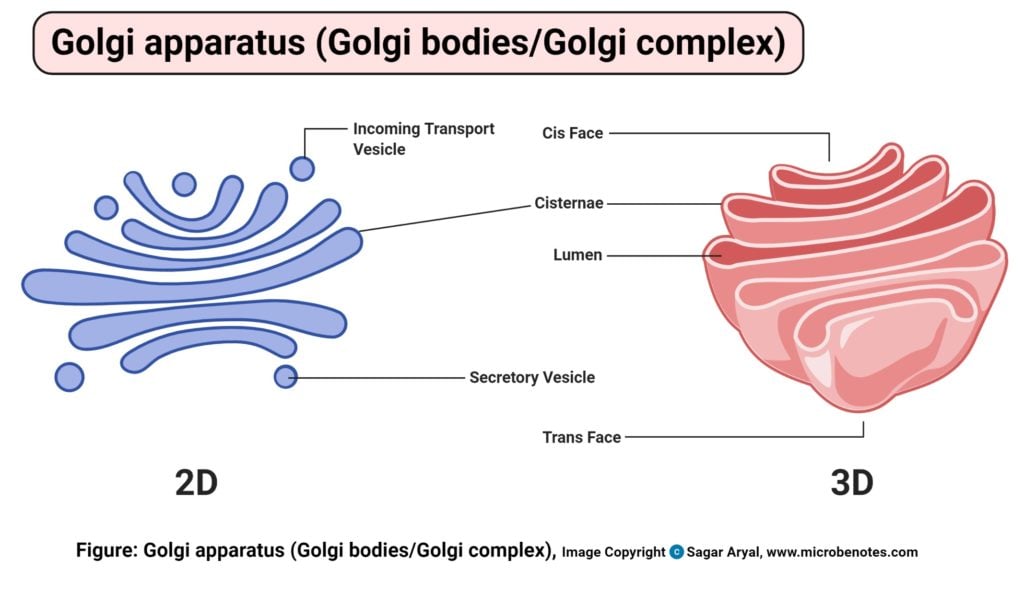
Figure created with biorender.com
Plant cell Golgi bodies definition
- These are complex membrane-bound cell organelles found in the cytoplasm of a eukaryotic cell, which is also known as the Golgi complex or Golgi apparatus. They lie just next to the endoplasmic reticulum and near the nucleus.
Structure of the Golgi bodies in a plant cell
- Golgi bodies are maintained together by cytoplasmic microtubules and clasped by a protein matrix
- They are made up of flattened stacked pouches known as cisternae.
- Plant cells have a few hundreds of the Golgi bodies moving along the cell's cytoskeleton, over the endoplasmic reticulum as compared to the very few found in animal cells (1-2).
- The Golgi bodies have three primary compartments:
- Cis Golgi network is also known as Goods inwards, are the cisternae the is closest to the endoplasmic reticulum. Also called the cis Golgi reticulum it is the entry area to the Golgi apparatus.
- The medial or the Golgi stack- this is the Main processing area, placed at the central layer of the cisternae
- Trans Golgi network is also known as the Goods outwards cisternae. This is the farthest cisternae endoplasmic reticulum from the endoplasmic reticulum.
Functions of the Golgi bodies in a plant cell
- The Golgi bodies have several functions linked to them, from being an adjacent organelle to the endoplasmic reticulum to where they deliver the cell products to. They are found in the middle of the cells' secretory pathway, as a membranous complex that primarily functions to process, distribute and store proteins for use by the plant during stress responses and others in leguminous plants such as cereals and grains.
- The presence of the membranous sac compartments, perform various chemically related functions. As new proteins are transported out of the endoplasmic reticulum through the Golgi bodies, they pass through the three compartments each compartment producing a different reaction to the molecules, modifying them in various ways i.e.
- Cleaving the protein molecules to oligosaccharides chains
- Attaching of sugar moieties of different side chains to the protein elements
- Addition of fatty acids and phosphate groups to the elements and removal of monosaccharides.
- The cell vesicles carrying protein molecules from the endoplasmic reticulum into the cis compartment, where the product is modified, and then packaged into other vesicles which then transports it to the next compartment. The transportation is enhanced by marking the vesicle with a tag like a phosphate group or special protein molecules, leading it to its next endpoint.
- Finally, when the vesicles have transported the proteins and lipid molecules, the Golgi bodies are responsible for assembling the product and transporting it to the final destination. This is enhanced by the presence of enzymes in the plants' Golgi bodies, which attache to the sugar moieties to the proteins, packing them and transporting them to the cell wall.
Nucleus of Plant Cell
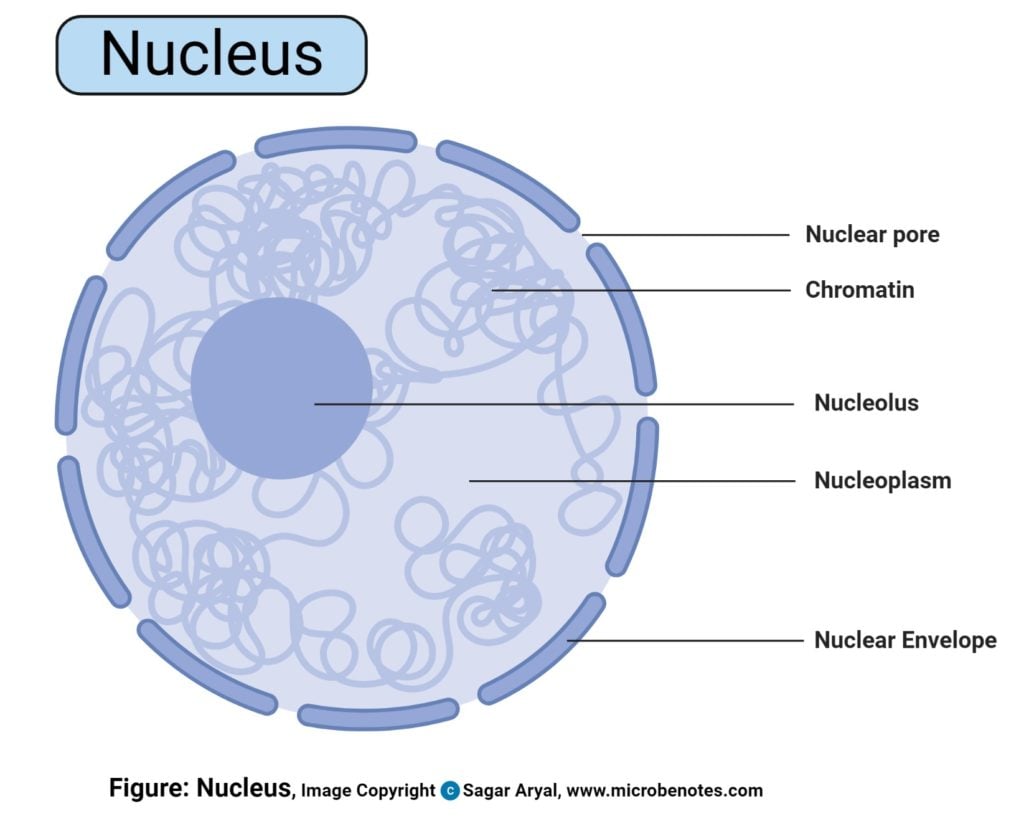
Figure created with biorender.com
Plant cell nucleus definition
- The nucleus is the information center of a cell. It is a specialized complex organelle whose primary function is to store the cell's genetic information.
- It is also responsible for coordinating the cell's activities including cell metabolism, cell growth, synthesis of proteins and lipids and generally the cell reproduction by cell division mechanisms.
- The nucleus contains the cells' genetic information known as Deoxyribonucleic Acid (DNA), on the Chromosomes (special thread-like strands of nucleic acids and protein found in the nucleus, carrying genetic information)
Structure of the nucleus of the plant cell
- The nucleus is spherically shaped, centrally placed in the cell. It occupies about 10% of the cell volume content.
- It as a double-layered membrane known as the nuclear envelope which separates the contents in the nucleus from those in the cell cytoplasm.
- The nuclear materials included chromatins, DNA which forms the cell chromosomes during cell division, the nucleolus which is responsible for synthesizing the cell ribosomes.
Functions of the nucleus of the plant cell
- The Primary role of the cell nucleus is, it functions as the cell's control center.
- The presence of the nuclear membrane, it encloses the nucleus and its contents from the cytoplasmic organelles. This nuclear membrane has the nuclear envelope, which has several nuclear pores, which offers selective permeability to and from the nucleus and the cytoplasm.
- The nucleus is also linked to the site for protein synthesis, i.e the endoplasmic reticulum by a network of microfilaments and microtubules. These tubules extend all over the cell manufacturing elements and molecules depending on the specificity of the cell.
- Chromosomes: they are also known as the chromatids. They are found in the cell nucleus of almost all cells. They have 6 long strands of DNA which divide into 46 separate molecules which pair up into two, made of 23 molecules per chromosome. To form a functional DNA unit, it is combined with cel proteins to form a compact structure of dense fiber-like strands known as the chromatins.
- The 6 DNA strands, each wraps around small protein molecules produced by the ER known as Histones. These form the beadlike structures known as nucleosomes. DNA strands have a negative charge which is neutralized by the histones' positive charge. Unused DNA is folded and stored for future use.
Chromatins are classified into two types:
- Euchromatin: It is the active part of the DNA that is used for RNA transcription producing cellular protein for cell growth and functioning.
- Heterochromatin: it is the inactive part of DNA that has the compressed and condensed DNA that is not in use.
During Chromatin formation, the chromatins change into other forms of the nucleus during cell division. Throughout the life of a cell, chromatin fibers take on different forms inside the nucleus. During the interphase stage of cell division, the euchromatin is expressed to start transcription. Into the metaphase stage, the chromatins divide making its own copies during replication exposing the chromatins more to form more specialized structures known as chromosomes. These chromosomes then divide and separate, forming two new complete cells, with their own genetic information.
Nucleolus
- It is a sub-organelle in the cell nucleus, which lacks a membrane.
- Its primary function is to synthesize the cell ribosomes, the organelles used to produce cellular proteins.
- The cell has about 4 nucleoli.
- The nucleolus is formed when chromosomes are brought together, just before cell division is initiated.
- The nucleolus disappears from during cell division.
- The nucleolus is linked to cell aging which affects the aging of living things.
Nuclear Envelope
- Its made up of two membranes separated from each other by perinuclear space. the space links into the endoplasmic reticulum.
- With its perforated wall, it regulates the molecules that enter and leave the nucleus into and out of the cytoplasm respectively.
- The inner membrane has a lining of proteins known as nuclear lamina, binding chromatins, and other nuclear elements.
- The envelope disintegrates and disappears during cell division.
Nuclear Pores
- They are perforate the cell envelope and their function is to regulate the passage of cellular molecules such as proteins, histones through into and out of the nucleus and the cytoplasm respectively.
- They also allow DNA and RNA into the nucleus, providing energy for making up the genetic materials.
Peroxisomes of the Plant cell

Figure created with biorender.com
Plant cell peroxisomes definition
These are highly dynamic tiny structures that have a single membrane containing enzymes responsible for the production of hydrogen peroxide. They play major roles in primary and secondary metabolisms, responding to abiotic and biotic stress in regulating photorespiration and cell development.
Structure of the peroxisomes
- Peroxisomes are small with a diameter of 0.1-1 µm diameter.
- It is made up of compartments having a granulated matrix.
- They also have a single membrane layer.
- They are found in the cytoplasm of a cell.
- The compartments assist in various metabolic processes of the cell to help sustain the cellular activities within the cell.
Functions of the peroxisomes
- Production and degradation of hydrogen peroxide
- oxidation and metabolism of fatty acids
- Metabolizing carbon elements
- Photorespiration and absorption of Nitrogen for specific functions of the plant.
- Providing defense mechanisms against pathogens
Lysosomes in plant cells?

Figure: Lysosomes created with biorender.com
The presence of lysosomes in plants has been long debated over with little evidence on their structural presence. In plants, Its believed that lysosomes partially differentiate into vacuoles and partially into the Golgi bodies, which perform the functions stipulated for lysosomes in plants. Unlike in animals where lysosomes distinctively posses hydrolytic enzymes and digestive enzymes, for breaking down toxic materials and removing them from the cell and digestion of proteins respectively, in plants these enzymes combined are found in the vacuoles and the Golgi bodies.
The partial differentiation has been liked to the multiprocess that contribute to the formation of Golgi bodies from the endoplasmic reticulum, whereby, there is a short phase of lysosomal exudation just before Golgi bodies are fully formed.
References and sources
- 1% – https://publishing.cdlib.org/ucpressebooks/view?docId=ft796nb4n2&chunk.id=d0e6787&toc.depth=1&brand=eschol
- 1% – https://lifeofplant.blogspot.com/2011/04/endoplasmic-reticulum.html
- <1% – https://www.thoughtco.com/what-is-a-plant-cell-373384
- <1% – https://www.thoughtco.com/thylakoid-definition-and-function-4125710
- <1% – https://www.thoughtco.com/organelles-meaning-373368
- <1% – https://www.thoughtco.com/mitochondria-defined-373367
- <1% – https://www.thoughtco.com/golgi-apparatus-meaning-373366
- <1% – https://www.thoughtco.com/endoplasmic-reticulum-373365
- <1% – https://www.thoughtco.com/cell-wall-373613
- <1% – https://www.studyblue.com/notes/note/n/mitosis-mb/deck/2549642
- <1% – https://www.studyblue.com/notes/note/n/biology-41/deck/4445193
- <1% – https://www.sciencedirect.com/science/article/pii/B9780128132784000117
- <1% – https://www.researchgate.net/publication/51769784_Crystal_Structure_of_the_Eukaryotic_60S_Ribosomal_Subunit_in_Complex_with_Initiation_Factor_6
- <1% – https://www.researchgate.net/publication/11624368_Primary_and_secondary_plasmodesmata_Structure_origin_and_functioning
- <1% – https://www.reference.com/science/three-organelles-involved-protein-synthesis-f6b78c5c64edf09f
- <1% – https://www.reference.com/science/mitochondria-called-powerhouse-cell-1be9734280fe6541
- <1% – https://www.quora.com/What-is-the-role-of-central-vacuoles-in-plants
- <1% – https://www.quora.com/What-is-the-function-of-the-cell-wall-in-plant-cells
- <1% – https://www.quora.com/How-do-plants-store-carbohydrates
- <1% – https://www.ncbi.nlm.nih.gov/pmc/articles/PMC4556774/
- <1% – https://www.ncbi.nlm.nih.gov/books/NBK9930/
- <1% – https://www.ncbi.nlm.nih.gov/books/NBK9927/
- <1% – https://www.ncbi.nlm.nih.gov/books/NBK9845/
- <1% – https://www.ncbi.nlm.nih.gov/books/NBK26928/
- <1% – https://www.ncbi.nlm.nih.gov/books/NBK26857/
- <1% – https://www.khanacademy.org/science/biology/structure-of-a-cell/tour-of-organelles/v/cytoskeletons
- <1% – https://www.khanacademy.org/science/biology/cellular-respiration-and-fermentation/pyruvate-oxidation-and-the-citric-acid-cycle/a/the-citric-acid-cycle
- <1% – https://www.histology.leeds.ac.uk/bone/bone.php
- <1% – https://www.genome.gov/genetics-glossary/Nucleolus
- <1% – https://www.dictionary.com/browse/cell-membrane
- <1% – https://www.coursehero.com/file/p3ddivl/Cytoskeleton-The-cytoskeleton-is-a-network-of-interconnected-filaments-and/
- <1% – https://www.cell.com/cell/fulltext/S0092-8674(00)80379-7
- <1% – https://www.britannica.com/science/protoplast
- <1% – https://www.britannica.com/science/endoplasmic-reticulum
- <1% – https://www.britannica.com/science/chloroplast
- <1% – https://www.britannica.com/science/cell-wall-plant-anatomy
- <1% – https://www.answers.com/Q/What_is_the_nucleus_of_the_plant_cell
- <1% – https://study.com/academy/lesson/endoplasmic-reticulum-definition-functions-quiz.html
- <1% – https://socratic.org/questions/how-does-rough-endoplasmic-reticulum-differ-from-smooth-endoplasmic-reticulum
- <1% – https://sciencing.com/type-energy-produced-photosynthesis-5558184.html
- <1% – https://quizlet.com/96414686/biology-photosynthesis-flash-cards/
- <1% – https://quizlet.com/86414399/dna-flash-cards/
- <1% – https://quizlet.com/61862488/cell-growth-and-division-flash-cards/
- <1% – https://quizlet.com/54446192/unit-4-cell-reproduction-dna-flash-cards/
- <1% – https://quizlet.com/53192582/ch-9-the-nuclear-envelope-and-traffic-between-the-nucleus-and-the-cytoplasm-flash-cards/
- <1% – https://quizlet.com/52153414/cellular-respiration-flash-cards/
- <1% – https://quizlet.com/47367402/animal-and-plant-cells-flash-cards/
- <1% – https://quizlet.com/45353409/bisc-1005-online-chapter-4-flash-cards/
- <1% – https://quizlet.com/369659702/photosynthesis-flash-cards/
- <1% – https://quizlet.com/32529303/biology-chapter-9-flash-cards/
- <1% – https://quizlet.com/27702154/eukaryotic-cells-flash-cards/
- <1% – https://quizlet.com/239755666/biology-chapter-6-7-8-flash-cards/
- <1% – https://quizlet.com/192860439/exam-2-flash-cards/
- <1% – https://quizlet.com/154091502/botany-chapter-3-quiz-flash-cards/
- <1% – https://quizlet.com/13271094/the-cell-flash-cards/
- <1% – https://quizlet.com/117076625/plasmodesmata-flash-cards/
- <1% – https://microbenotes.com/animal-cell-definition-structure-parts-functions-and-diagram/
- <1% – https://micro.magnet.fsu.edu/cells/plants/vacuole.html
- <1% – https://micro.magnet.fsu.edu/cells/plants/nucleus.html
- <1% – https://micro.magnet.fsu.edu/cells/nucleus/nucleus.html
- <1% – https://lifeofplant.blogspot.com/2011/01/ribosomes.html
- <1% – https://labs.wsu.edu/knoblauch/sieve-element-plasids/
- <1% – https://en.wikipedia.org/wiki/Ribosome
- <1% – https://en.wikipedia.org/wiki/Ribosomal_RNA
- <1% – https://en.wikipedia.org/wiki/Prokaryotes
- <1% – https://en.wikipedia.org/wiki/Plastid
- <1% – https://en.wikipedia.org/wiki/Plasmodesmata
- <1% – https://en.wikipedia.org/wiki/Plasmodesma
- <1% – https://en.wikipedia.org/wiki/Plant_cells
- <1% – https://en.wikipedia.org/wiki/Nucleus_(cell)
- <1% – https://en.wikipedia.org/wiki/Lipopolysaccharide
- <1% – https://en.wikipedia.org/wiki/Endoplasmic_reticulum
- <1% – https://en.wikipedia.org/wiki/DNA
- <1% – https://en.wikipedia.org/wiki/Cytoskeleton
- <1% – https://en.wikipedia.org/wiki/Chloroplast_membrane
- <1% – https://en.wikipedia.org/wiki/Chloroplast
- <1% – https://en.m.wikipedia.org/wiki/Plastid
- <1% – https://en.m.wikipedia.org/wiki/Cytoskeleton
- <1% – https://en.jinzhao.wiki/wiki/Ribosome
- <1% – https://byjus.com/biology/plastids/
- <1% – https://bscb.org/learning-resources/softcell-e-learning/golgi-apparatus/
- <1% – https://brainly.com/question/11508030
- <1% – https://biologywise.com/structure-functions-of-cytoplasm
- <1% – https://biologywise.com/smooth-endoplasmic-reticulum
- <1% – https://biologywise.com/plant-cell-organelles
- <1% – https://biologywise.com/golgi-apparatus-function
- <1% – https://biologywise.com/cell-wall-function
- <1% – https://biology-online.org/biology-forum/viewtopic.php?t=12023
- <1% – https://biologyeducare.com/endoplasmic-reticulum/
- <1% – https://anydifferencebetween.com/difference-between-intermediate-filaments-and-microfilaments/
- <1% – http://www.yourarticlelibrary.com/biology/3-most-important-layers-of-cell-wall-735-words/6289
- <1% – http://www.nios.ac.in/media/documents/dmlt/Biochemistry/Lesson-05.pdf
- <1% – http://www.brainkart.com/article/Structure-of-the-plant-cell_14099/
- <1% – http://nzetc.victoria.ac.nz/tei-source/Bio11Tuat03.xml
- Plant peroxisomes by Mano S., Nishimura M.
- nature.com/scitable/topicpage/plant-cells-chloroplasts-and-cell-walls-14053956/
- https://www.quora.com/Do-plant-cells-have-lysosomes-Why-or-why-not
rutherfordtraturd.blogspot.com
Source: https://microbenotes.com/plant-cell/
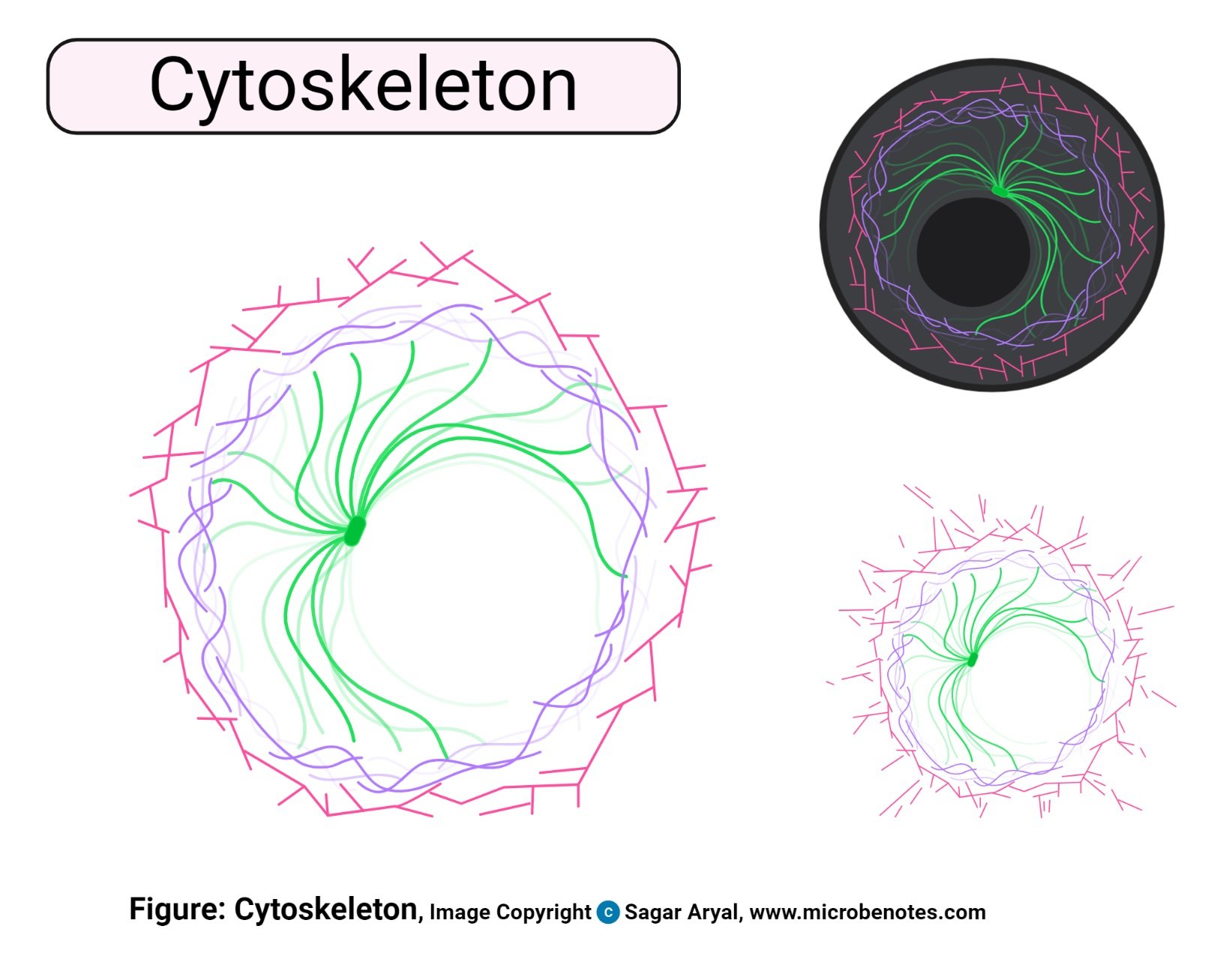
0 Response to "Illustration of a Plant Cell Easy 7th Grade"
Post a Comment